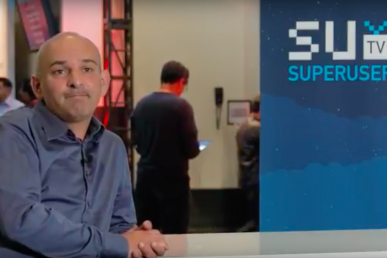The Open Networking Foundation (ONF), founded in 2011, first broke new ground on the software-defined networking frontier.
Now, with over 200 members and a board that includes AT&T, Google, NTT Communications, SK Telecom and Verizon, they’re streamlining operations. At the recent Linux Foundation Open Source Leadership Summit, they launched the Open Innovation Pipeline, which marries efforts of the ONF and Open Networking Lab (ON.Lab). Merging the two organizations will take the better part of 2017, but that won’t halt progress.
Superuser talks to ONF’s chief development officer Bill Snow about how the telcos play together, the upshot of the Pipeline for XOS — a service management toolkit built on top of OpenStack — and how you can get involved.
What’s your role with the ONF?
I started the Open Networking lab (ON.Lab) with Guru Parulkar five years ago and our mission is to bring better networks for the public good. So, for five years we have been developing platforms and tools for doing that. The big one is ONOS, the controller. As we built out ONOS we did so by working with network operators on typical use cases they wanted. One of those was called CORD, and CORD started as a residential access, a way to bring agility and better economics to the engine and network for these optical connections and we did that working closely with AT&T…My current role is to run the engineering team at Networking lab that provides a core set of developers to both ONOS and to CORD.
What compelled you to get involved with the Open Networking Foundation?
I spent my career in networking and watched it get locked up. And without innovation, things kind of shrivel and die. That was fine as long as everything was just connected computers. But when we moved to the world of mobile and video became so huge, all of a sudden you had all these network operators. And there were no longer the economics for them to keep growing their network to keep up with these workloads. So it was a tremendous opportunity to help the whole ecosystem move to more fertile ground for innovation and to bring much better communications infrastructures. So that’s been my motivation.
How do these competing companies work together? How much refereeing is involved?
They play amazingly well together. In fact at the Open Networking Lab, we have as many partner engineers and operator engineers as we do lab engineers and, quite frankly, we kind of lose track of who works for whom. So for example you have SK Telecom, Verizon, AT&T working together hand-in-hand on the mobile version of CORD. And although they end up being competitors in some markets, they also have the same goal for making this infrastructure much more agile, much more cost efficient. So that gives them really some common ground to work hard together.
What kind of contributions are you looking for now from the outside?
We have so many solutions and so many activities. We have 17 partner organizations, but we also have over a 150 collaborating organizations. So there’s a lot of companies involved in the different use cases that we’re driving out for the operators. And what you saw in the announcement from the Innovation Pipeline was really us just articulating the process that we use to take all of this componentry, whether it’s disaggregated hardware, monetized hardware, or the open-source software pieces. Somebody has to bring those together into solutions for the operator.
This creates a new value chain and along the value chain different collaborators or partners bring in different pieces. And they work together to bring that whole solution either to a POC or to a lab trial or field trial, maybe even out into production. So everything we undertake starts with operator or a group of operators saying this is important to us. And then we build a ecosystem of developers around that through our community efforts, community outreach, and drive it as far as make sense for the operator, out towards production.
XOS is the project that most directly intersects with OpenStack, tell me a bit about it.
XOS provides a platform that can really bring VNFs together and create services. It’s all about service creation and it does so at the top layer from taking in a TOSCA or maybe even a Yang-type specification. Some way of specifying a service and so it has a data model that gets driven to do all the changes that are needed. Some of those changes are starting up virtual machines in OpenStack, some are getting virtual networks to interconnect these VNFs. So OpenStack has been a fundamental piece of the infrastructure…XOS is a layer that sees everything as a service and so through OpenStack and the network service or VNFs as a service … Now there’s a lot of interest and there’s a lot of deployments of OpenStack in the operator space, but there’s also instances where operators are not using OpenStack, right? So XOS has to also be able to utilize other infrastructure services, whether it’s Kubernetes or one of the other container ecosystems.
What will the Pipeline mean for XOS?
So the Pipeline provides points where you can do replacements. So in this case, getting virtual service can be done through OpenStack or it could be done through a different service. Same with controllers. We currently use ONOS but there’s no reason that we couldn’t use ODL or open controller or another controller. Whatever an operator wants to use. And then this is where we tie together the Open Network Foundation with the open source software because the intersection between these components and where you can replace them —that’s where you want to standardize some interfaces.
One of the analyst comments about the new Pipeline was that it won’t replace proprietary networking, but put more pressure on traditional networking vendors. If that’s the case, do you think it’s good or a bad?
So I think that there’s truly a need in the market place… If any of us want better network services, change has to happen, right? And of course change is painful for the incumbents who perhaps own most of the customers. And so bringing the innovation back in ultimately is painful for the incumbents, but these are very powerful corporations with a lot of smart people. And I wouldn’t count any of them out, right? They will all find ways to come with this, bring back their value and probably continue growing.
Anything else you want to make sure that OpenStack folks know about the Pipeline or about the ONF?
OpenStack is a really important part of the infrastructures that are in place. In the past, maybe OpenStack networking wasn’t as comprehensive or as good as it could have been. There’s been some efforts around making it better. So I think making virtual networking easy as a part of OpenStack would be wonderful.
What’s the main way that Stackers can help with that?
Probably through the same type of thing that we do. Working with an operator or an enterprise to drive a use case that really is demanding on virtual networking and see what can be learned from that.
Get involved!
You can check out the GitHub repository and if your company is already a member, sign up for access to the Wiki, working groups, mailing lists etc. If you want your company or research organization to join, more here.
You’ll also find the ONF present through demos and workshops at the upcoming Mobile World Congress and Open Networking Summit. For more on workshops and conferences where they participate, check out their events page.
Cover Photo // CC BY NC
- OpenStack Homebrew Club: Meet the sausage cloud - July 31, 2019
- Building a virtuous circle with open infrastructure: Inclusive, global, adaptable - July 30, 2019
- Using Istio’s Mixer for network request caching: What’s next - July 22, 2019

)











